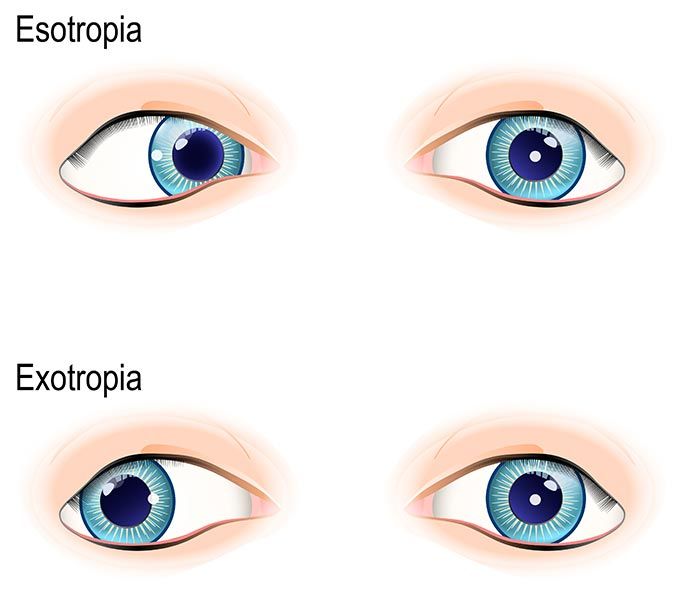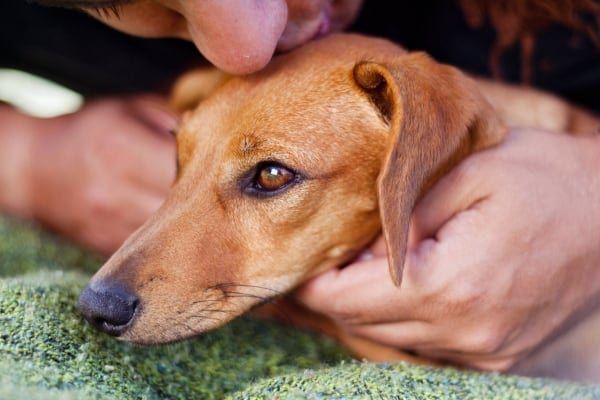What is Strabismus in Dogs?
Strabismus is a condition in which the eyes are not properly aligned with each other. It causes the dog’s eyes to point in different directions. Strabismus is sometimes called “squinting”, “cross-eyed”, or “walleye”.
There are two main types of strabismus in dogs:
- Esotropia – the eye turns inward toward the nose
- Exotropia – the eye turns outward away from the nose

Strabismus is usually caused by one of the eye muscles becoming weaker than the others. This means the dog can no longer keep the eyes aligned properly. Some common causes include:
- Injury or trauma to the head or eyes
- Underlying neurological conditions
- Congenital defects present from birth
- Glaucoma
- Tumors behind the eye
Common symptoms of strabismus in dogs include:
- Eyes pointing in different directions
- Difficulty judging distances and depths
- Clumsy movements and bumping into objects
- Head tilt or turn to align vision
- Rubbing at the eyes
If left untreated, strabismus can cause vision loss or impairments, depth perception problems, and loss of coordination. Early treatment is important to realign the eyes and restore proper vision.
Diagnosing Strabismus in Dogs
If you suspect your dog has strabismus, the first step is to take them to the veterinarian for a full eye exam. The vet will evaluate your dog’s eyes to look for misalignments and rule out other possible causes for the appearance of crossed eyes, like injury, infection, or neurological problems.

Your veterinarian has several tests at their disposal to diagnose strabismus and determine the underlying cause:
- Ophthalmic exam – The vet will look at the external structure of the eye and inside the eye using an ophthalmoscope to examine the retina and optic nerve.
- Schirmer tear test – This test measures tear production to test for dry eye (keratoconjunctivitis sicca), which can sometimes cause strabismus.
- Fluorescein stain – This dye is applied to the eye to detect scratches, ulcers or other damage to the surface of the eye.
- Vision testing – The vet may perform tests to evaluate your dog’s vision and depth perception.
- Neurologic examination – If a neurological problem is suspected, your vet may test your dog’s reflexes and coordination.
- Imaging – X-rays or an MRI may be recommended to check for underlying structural problems or inflammation.
Based on the results of the eye exam and diagnostic testing, the vet can determine the type and cause of strabismus in your dog. This allows them to recommend the most appropriate treatment options.
Treating Strabismus in Dogs
There are several treatment options available for dogs with strabismus depending on the underlying cause and severity of the condition. The main treatments include:
Surgery
Surgery is often recommended to realign the eye and correct extraocular muscle abnormalities causing strabismus. The surgical procedure is called a recession-resection surgery, which involves recessing (loosening) and resecting (tightening) specific eye muscles to reposition the eye. Surgery is usually done under general anesthesia and has a good success rate for fully correcting strabismus and improving vision in dogs.
Vision Therapy
Vision therapy involves doing targeted eye exercises and activities to train the eyes to work together correctly. It helps strengthen eye muscles, improves control and coordination between the eyes, and trains the brain to process binocular vision properly. Vision therapy aims to reestablish proper alignment and fusion to correct strabismus and associated vision problems.
Eye Exercises
Simple eye exercises and training activities done regularly at home can help strengthen eye muscles, stimulate binocular vision, and supplement vision therapy. Some recommended eye exercises include using toys and treats to train the dog to follow objects with both eyes together, tracking exercises using hand movements and LED pointer lights, balancing on unstable surfaces which require eye coordination, and obstacle courses or agility exercises which stimulate binocular vision.
Eye Exercises for Strabismus in Dogs
Eye exercises are an important part of treatment for strabismus in dogs. Performing regular eye exercises can help strengthen the eye muscles and improve eye alignment and coordination. Here are some of the main types of eye exercises for dogs with strabismus:

Tracking Exercises
Tracking exercises involve having your dog follow a moving object with just their eyes, keeping their head still. Slowly move a toy or treat from side to side, up and down, in circles, and in a figure 8 pattern. Start with the object close to your dog’s face and gradually increase the distance as their tracking improves. This helps strengthen eye muscles on both sides.
Saccades
Saccades are rapid eye movements from one object to another. Hold two toys or treats about 6-12 inches apart at your dog’s eye level. Say your dog’s name to get their attention then quickly switch which object you point to, having them look back and forth. Start slowly and increase speed. This improves eye coordination.
Convergence Exercises
Convergence exercises help strengthen muscles that allow both eyes to focus together on a near object. Hold a treat or toy in front of your dog’s nose, then slowly bring it in toward their face keeping it centered, keeping their eyes on the object. Gradually bring it as close as your dog can maintain focus. This strengthens convergence.
Perform these eye exercises with your dog 2-3 times per day for 5-10 minutes. Keep sessions positive and fun by pairing with praise, play, and treats. Be patient as your dog learns these new skills. With regular practice, eye exercises can significantly improve eye alignment and vision in dogs with strabismus.
Follow-up Care After Exercises
After your dog completes an initial course of eye exercises for strabismus with the veterinarian, it will be important to continue the exercises at home. The veterinarian will demonstrate the proper technique and explain how often the exercises should be done.
Typically, the eye exercises will need to be performed 3-5 times per day. Each session may involve repeating the exercise 5-10 times per eye. It’s critical to follow the veterinarian’s instructions carefully and perform the exercises consistently to help strengthen the eye muscles and improve eye alignment.
Schedule regular follow-up appointments with the veterinarian to monitor your dog’s progress. These exams allow the vet to check if the strabismus is improving and make any adjustments to the exercise regimen. Expect to visit the vet every 2-4 weeks during the initial treatment period. Over time, the exams may be needed less frequently, such as every 6-12 months.
Keep communicating with your veterinarian about how your dog responds to the eye exercises. This will help determine if the current approach is working or if any changes need to be made. With consistent at-home therapy and follow-up vet care, eye exercises can be an effective way to manage strabismus in dogs.
Lifestyle Changes
Making some adjustments to your dog’s lifestyle can help manage strabismus and prevent worsening of the condition. Here are some tips:
Provide Mental Stimulation
Dogs with strabismus can have trouble with depth perception and visual processing. Providing mental exercise with interactive toys, obedience training, and games can help keep their minds engaged. Work on tricks and commands that rely on other senses like hearing and smell. Teaching new skills also provides mental workout. Just be patient and supportive as your dog adapts.
Limit Stairs and Jumping
Climbing up and down stairs can be disorienting and dangerous for dogs with strabismus. Limit access to stairs when possible. Also avoid activities that involve jumping like playing fetch, catching frisbees etc. Take your dog on flat walks instead of runs and hikes which require depth perception. This will help prevent injuries and worsening of the condition.
Outlook for Dogs with Strabismus
With early detection and treatment, most dogs with strabismus can lead happy, comfortable lives. The prognosis for vision depends on the underlying cause.
For dogs with congenital strabismus present from birth, the prognosis is good if treatment begins before 3-4 months of age. The younger the dog is treated, the better the chances for developing vision in the misaligned eye. If left untreated, the vision in the affected eye will deteriorate over time.
For dogs who develop strabismus later in life due to disease, injuries or neurological issues, the prognosis depends on the underlying condition. With appropriate treatment of the primary disease and strabismus management, vision can often be preserved or improved. However, nerve damage or scarring may lead to irreversible vision loss.
With committed treatment and monitoring, most dogs adapt well to long-term vision impairment or blindness. They rely more on their other senses and can live happily into old age. Owners will need to take precautions to protect their dog’s quality of life. But with some adjustments at home, dogs with strabismus can continue to lead fulfilling lives.
Preventing Strabismus in Dogs
There are a few things that can be done to try to prevent strabismus from developing in dogs:

Selective Breeding
Since certain breeds like Boston Terriers, Chihuahuas, and Pugs are predisposed to strabismus, responsible breeders should aim to breed dogs free from this condition. Dogs used for breeding should be screened by a veterinary ophthalmologist and only those found to be free of eye abnormalities should be bred. This can help reduce the incidence of inherited strabismus in susceptible breeds.
Nutrition
Providing proper nutrition is important for eye health. Puppies should be fed a high-quality diet formulated for growth that contains optimal levels of nutrients like amino acids, vitamins A, C, and E, and omega-3 fatty acids from fish oil. These nutrients support eye development and function. For adult dogs, continuing to feed a nutritious diet with antioxidants can help maintain healthy eyes.
Avoiding nutritional deficiencies or excesses is also important, as these can potentially contribute to certain eye problems. Work with your veterinarian to choose an appropriate diet for your dog’s life stage and activity level to support eye health.
Living with a Dog with Strabismus
When you learn your dog has strabismus, it can be difficult to come to terms with initially. Your dog may look and act a bit different than before. However, with patience, love and care, you and your dog can still enjoy your relationship. Be gentle and understanding as your dog adapts to new exercises or treatments. Work closely with your veterinarian to ensure the best outcome. Most of all, make sure your dog still feels your unconditional love and support.
Ongoing care is an important part of living with a dog with strabismus. Attend follow-up vet visits as recommended to monitor progress. Be diligent about keeping up with prescribed eye exercises and medications. Watch for any changes in your dog’s eyesight and alert the vet if the strabismus seems worse. Your dog may need supplements or a specialized diet. Adapt your home and outdoor spaces if needed to accommodate changes in vision. Most importantly, give your dog lots of affection, patience and encouragement through this process.
When to See a Veterinarian
If your dog’s strabismus is getting worse or causing new problems, take him to the vet. Signs that the condition is progressing or affecting your dog’s vision include:
-
Changes in the appearance of the eyes – the eyes turning in different directions, changes in the angle of strabismus, redness, swelling, discharge, etc.
-
Bumping into objects or having difficulty navigating around obstacles
-
Hesitation or clumsiness when going up or down stairs
-
Difficulty catching treats or toys
-
Changes in behavior like anxiety, fearfulness, or irritation
-
Pawing at the eyes
-
Rubbing the eyes on furniture or the floor
-
Sudden regression in training – having potty accidents in the house when previously housebroken, no longer responding to commands, etc.
If you notice any of these signs, schedule an appointment with your veterinarian right away. Your vet can examine your dog’s eyes, determine if the strabismus is worsening, and discuss options for managing or improving your dog’s condition.